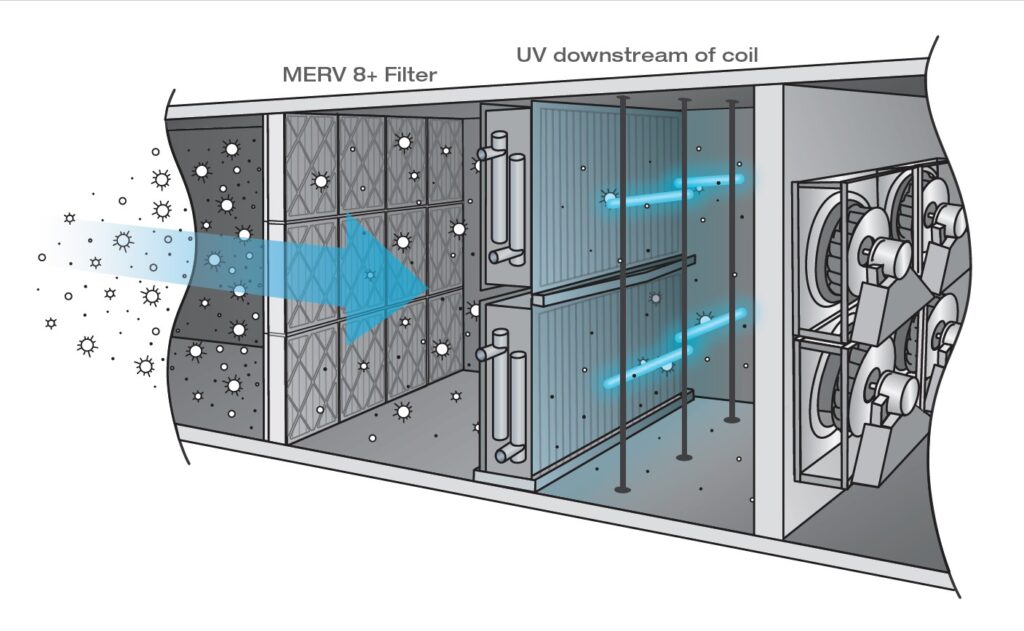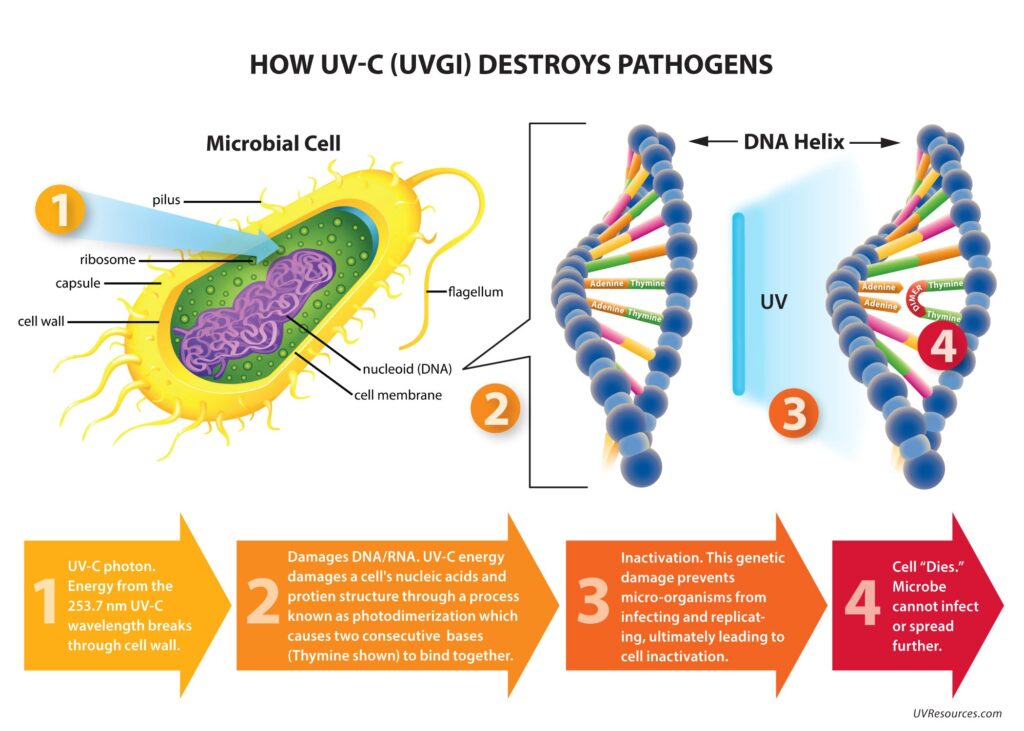Long before the pandemic, researchers knew that poor indoor air quality (IAQ) made workers sick and decreased cognition and attendance.
A Harvard study of more than 3,000 workers showed that sick leave doubled among employees in poorly ventilated areas. Poor air IAQ has also been shown to decrease office workers’ cognitive function and decision-making, as well as lower student reading and math achievement, damage teacher retention, and worsen morale at schools. Since the COVID-19 pandemic began, many recommended HVAC-oriented infection mitigation strategies have revolved around increased ventilation, increased filter efficiency, and ultraviolet energy—often in a layered approach. The underlying infection control strategy herein is to dilute (ventilation) or remove (filter, UVGI) pathogen concentrations.

But what happens when infection mitigation objectives inadvertently inhibit ventilation levels? In other words, what happens when the HVAC equipment onsite is not mechanically capable of delivering the recommended air filtration performance?
Unintended Consequences of MERV 13
ASHRAE guidance—and, by extension, the Centers for Disease Control and Prevention (CDC)—recommend facility managers upgrade HVAC filters to the equivalent of a MERV 13 (Minimum Efficiency Reporting Value) rating.
However, HVAC operators have realized that, while higher filter efficiency will reduce airborne pathogen levels, the increased static pressure stemming from MERV 13 air filters can generate unintended consequences.
A higher efficiency filter, combined with the natural loading of the filter with pollutants, can decrease overall airflow levels to the point where HVAC systems cannot deliver the required airflow to the space. Apart from the fact that some HVAC systems cannot drive enough air through a MERV 13 filter to meet demand, those that are capable will expend more energy to compensate for the increased resistance.
Fortunately, there is an easy-to-implement alternative for the millions of HVAC systems that were never intended to perform with MERV 13 or higher filter rating—and still comply with the CDC and ASHRAE Epidemic Task Force recommendations.
Through a layered approach, third-party research has shown that facility engineers can combine ultraviolet germicidal irradiation, or germicidal UV‑C, with medium-efficiency air filters (MERV 8).

In addition to the energy savings that result from the lower pressure drop associated with a MERV 8 filter (e.g., less resistance, lower fan energy), building owners can significantly reduce annual filter costs. The less-restrictive MERV 8 filters cost considerably less than their MERV 13 counterparts and require fewer change-outs. Therefore, the more restrictive MERV 13 filters would likely need to be changed 5-6 times annually, while the MERV 8 filters would be changed quarterly.
Besides source control and increased ventilation, UVGI has been shown to complement filter operation. It’s important to note that UV‑C destroys the infectious material within the aerosol-based particles, so they are no longer contagious.
The combining or layering of air cleaning technologies has an exponential effect on an air handling unit’s (AHU) overall pathogen removal performance since the MERV 8 filter captures the larger pathogens, and the UV‑C inactivates the smaller, more susceptible pathogens.

Moreover, from a budgetary perspective, as noted above, the MERV 8 filter costs roughly half its more efficient MERV 13 counterpart. As a result, marrying UV‑C with a MERV 8 filter eliminates energy-intense system adjustments typically used to compensate for reduced airflows, such as increasing fan speed.
Energy Savings/HVAC Efficiency
In addition to mitigating pathogen concentrations, UV‑C slashes HVAC energy consumption by up to 20%. Adding UV‑C energy alone doesn’t save energy; instead, it restores coil and airflow performance near its original design capacity.
As HVAC/R equipment ages, microbial fouling or contaminant build-up decreases coil-heat transfer efficiency and degrades the air handler’s ability to remove heat. Once this build-up accumulates, it obstructs efficient heat removal—sort of like a barrier between the air and the cooling coil. As efficiency levels drop, humidity ratios increase—as not enough water is removed by the cooling coil—which generates poor IAQ levels and occupant complaints.
As heat transfer performance decreases, operators are forced to compensate with more energy-intense adjustments to try and meet demand, such as increasing fan speeds and decreasing chilled water temperatures. Once installed, UV‑C breaks down the organic build-up on the coil, heat transfer efficiency improves, and the pressure drop falls.
ASHRAE TC 2.9—the technical committee responsible for studying Ultraviolet Air and Surface Treatment—commissioned independent research that found the germicidal wavelength yielded an average pressure drop reduction of 21% and an increase in heat transfer coefficient of 14%. In this study, researchers found that most HVAC energy savings derived from applying UV‑C occurred in fan energy (80%), followed by cooling (17%) and pump energy (3%).

According to the U.S. Energy Information Administration, in March 2022, average U.S. commercial electricity prices were up 5% over the same period in 2021. Hotter and more humid summer temperatures and higher energy costs mean facility engineers must squeeze as much cooling and dehumidification as possible from HVAC systems.
IAQ: A Health & Safety Necessity
Today’s commercial facility managers and building engineers strive to keep building tenants safe and healthy while facing once-in-a-lifetime budgetary uncertainties wrought by the COVID-19 pandemic, including decreased occupancy rates, record inflation, and a slowing economy.
With HVAC operating budgets under pressure, UV‑C can lower energy consumption, increase cooling capacity, and improve air quality. In addition to the substantial operational savings, UV‑C fixtures installed in air handlers or HVAC ducts make workplaces safer, healthier, and more productive. This offers significant value to tenants uneasy about returning to work.
In a hybrid solution, a MERV 8 filter combined with a medium dose of UV-C—the amount typically applied for a coil cleaning/maintenance application—can exceed a 99% single-pass removal/inactivation rate for SARS-CoV-2. This removal rate surpasses the target MERV 13 filter performance recommended by ASHRAE.
Decades of peer-reviewed science validating UV disinfection efficacy and endorsements by the CDC and ASHRAE helped convince many property managers to embrace germicidal technology over unproven non-peer-reviewed technologies.
From a cost standpoint, UV‑C is among the most affordable HVAC maintenance strategies. A coil efficiency system can run as little as $0.15 to $0.20 per cfm. For a 20,000 cfm system, the equipment cost would be about $3,500 and provide year-round protection.

Dean Saputa is Vice President and Co-Founder of UV Resources. He currently serves as Chair of ASHRAE SPC‑185.2 (Method of Testing Ultraviolet Lamps) and as Secretary of GPC‑37 (Guidelines for the Application of Upper‑Air Ultraviolet Germicidal Devices to Control the Transmission of Airborne Pathogens). He may be reached at Dean.Saputa@UVResources.com
